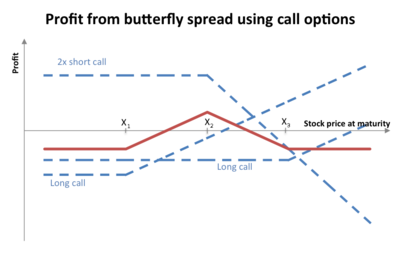| Revision as of 11:18, 16 April 2013 editHu12 (talk | contribs)91,877 edits rvt spam← Previous edit | Revision as of 11:15, 15 May 2013 edit undo176.252.98.79 (talk)No edit summaryNext edit → | ||
| Line 2: | Line 2: | ||
| ] | ] | ||
| In ], a '''butterfly''' is a limited risk, non-directional ] that is designed to have a large ] of earning a limited profit when the future ] of the ] is expected to be lower than the ]. | In ], a '''butterfly''' is a limited risk, non-directional ] that is designed to have a large ] of earning a limited profit when the future ] of the asset] is expected to be lower than the ]. | ||
| == Long butterfly == | == Long butterfly == | ||
Revision as of 11:15, 15 May 2013


In finance, a butterfly is a limited risk, non-directional options strategy that is designed to have a large probability of earning a limited profit when the future volatility of the asset] is expected to be lower than the implied volatility.
Long butterfly
A long butterfly position will make profit if the future volatility is lower than the implied volatility.
A long butterfly options strategy consists of the following options:
- Long 1 call with a strike price of (X − a)
- Short 2 calls with a strike price of X
- Long 1 call with a strike price of (X + a)
where X = the spot price (i.e. current market price of underlying) and a > 0.
Using put–call parity a long butterfly can also be created as follows:
- Long 1 put with a strike price of (X + a)
- Short 2 puts with a strike price of X
- Long 1 put with a strike price of (X − a)
where X = the spot price and a > 0.
All the options have the same expiration date.
At expiration the value (but not the profit) of the butterfly will be:
- zero if the price of the underlying is below (X − a) or above (X + a)
- positive if the price of the underlying is between (X - a) and (X + a)
The maximum value occurs at X (see diagram).
Short butterfly
A short butterfly position will make profit if the future volatility is higher than the implied volatility.
A short butterfly options strategy consists of the same options as a long butterfly. However all the long option positions are short and all the short option positions are long.
Variations of the butterfly
The double option position in the middle is called the body, while the two other positions are called the wings.
The option strategy where the middle two positions have different strike price is known as an Iron condor.
In an unbalanced butterfly the variable "a" has two different values.
References
- McMillan, Lawrence G. (2002). Options as a Strategic Investment (4th ed. ed.). New York : New York Institute of Finance. ISBN 0-7352-0197-8.
{{cite book}}:|edition=has extra text (help)